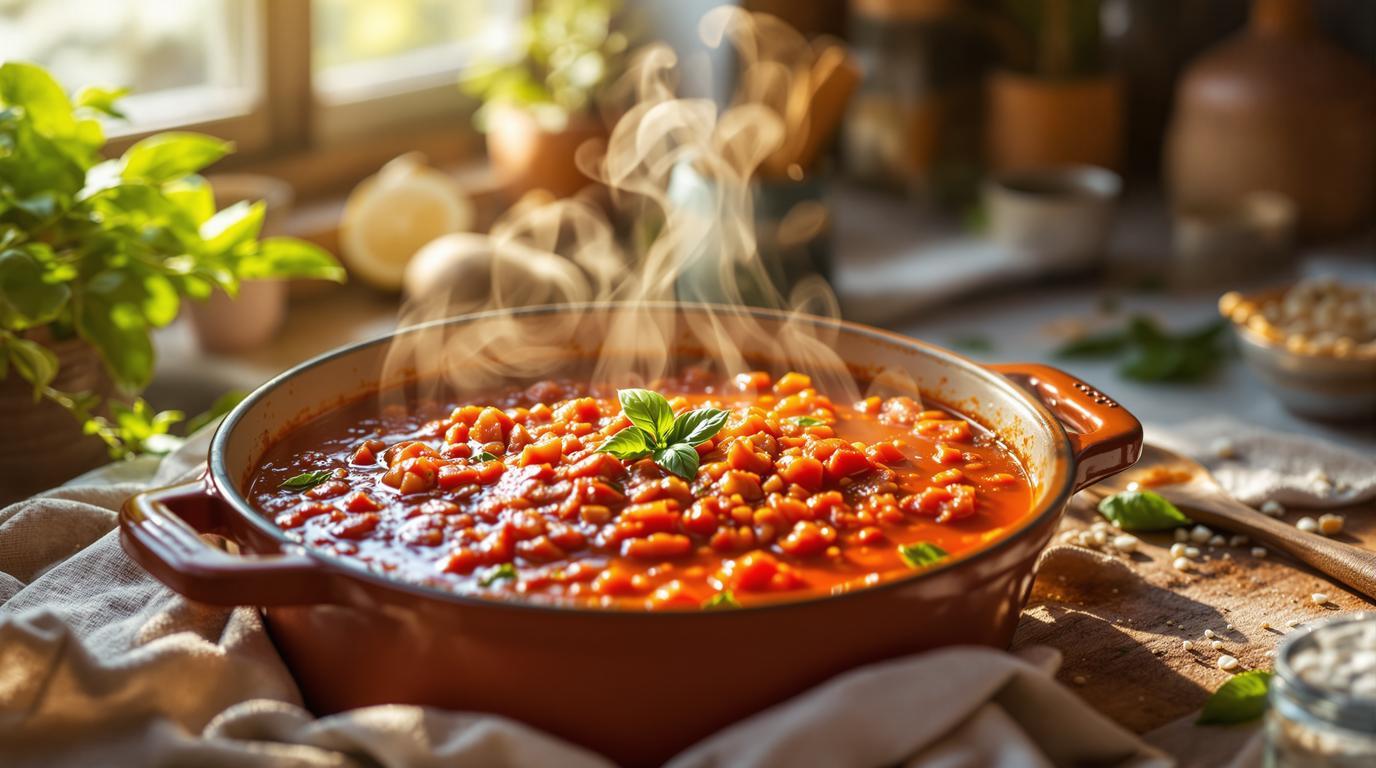There’s something magical about an authentic Italian tomato sauce that’s been simmered for hours, filling your home with that unmistakable aroma that seems to whisper stories from generations past. My grandmother always said, “The secret to a good sauce isn’t in fancy ingredients—it’s in how much love and patience you stir into the pot.” After cooking in restaurants across Italy, I discovered she was absolutely right. The humble tomato sauce is the backbone of Italian cuisine, and while it seems simple, achieving that perfect balance of sweetness, acidity, and depth takes both technique and heart. Today, I’m sharing my version of a true Nonna-style tomato sauce, complete with the traditional soffritto base that transforms ordinary tomatoes into something extraordinary.
The Heart of Italian Cooking: Traditional Tomato Sauce
Growing up in a bustling kitchen where sauce day was a sacred Sunday ritual, I learned that great tomato sauce requires three things: exceptional ingredients, gentle heat, and time. This slow-simmered sauce has that velvety richness that clings beautifully to pasta, creating what Italians call “il matrimonio perfetto”—the perfect marriage between sauce and pasta.
Essential Ingredients
For the Soffritto Base:
• 3 tablespoons extra-virgin olive oil (45ml)
• 1 tablespoon unsalted butter (15g)
• 1 medium yellow onion, finely diced (about 1 cup)
• 2 medium carrots, peeled and finely diced (about ¾ cup)
• 2 celery stalks, finely diced (about ½ cup)
For the Sauce:
• 4 cloves garlic, minced
• ½ cup dry red wine (preferably Chianti) (120ml)
• 2 (28-ounce) cans San Marzano whole peeled tomatoes (1.6kg total)
• 1 teaspoon sea salt, plus more to taste
• ½ teaspoon sugar (optional)
• 1 sprig fresh thyme
• ¼ cup fresh basil leaves, torn
Step-by-Step Method
- Create the flavor foundation: In a large, heavy-bottomed Dutch oven, heat the olive oil and butter over medium-low heat. Add the onion, carrots, and celery, stirring occasionally until the vegetables soften and the onions become translucent—about 8-10 minutes. This gentle cooking releases the natural sweetness without browning.
- Add the aromatics: Stir in the minced garlic and cook just until fragrant, about 60 seconds. Be vigilant here—garlic goes from perfectly golden to bitter and burnt in moments. This step reminds me of watching my aunt hover over the pot, wooden spoon in hand, ready to move things along at the precise moment.
- Deglaze with wine: Pour in the red wine and use your wooden spoon to scrape up all those flavorful caramelized bits from the bottom of the pot. Let the wine simmer until reduced by half, about 5 minutes.
- Add tomatoes: Pour in the San Marzano tomatoes with their juices. Use your wooden spoon to gently crush them against the side of the pot—leave some chunks for texture. Add salt, sugar (if using), and the sprig of thyme.
- Simmer patiently: Reduce heat to the lowest possible setting where the sauce barely bubbles. Cook uncovered for a minimum of 2 hours, stirring occasionally to prevent sticking. For truly exceptional depth, continue cooking for up to 6 hours. The sauce should reduce slightly and develop a rich, brick-red color.
- Finish with fresh herbs: Remove the thyme sprig. Turn off the heat and stir in the torn basil leaves. Taste and adjust seasoning if needed.
Chef’s Note: The magic of this sauce happens during the long, slow simmer. It’s not something you can rush. This gentle reduction concentrates flavors while allowing the natural sugars in the vegetables and tomatoes to caramelize slightly, creating that distinctive sweetness that balances the acidity. If you absolutely must speed things up, you can add a tiny pinch of baking soda to neutralize acidity—but I prefer the traditional slow-cooked approach.
Professional Tips for Perfect Sauce
• Tomato selection matters: San Marzano tomatoes are worth the extra cost for their sweet flavor and low acidity. If unavailable, look for whole peeled plum tomatoes—they’re less processed than crushed or diced varieties.
• Texture control: For a silkier sauce, pass through a food mill after cooking. For a more rustic texture (my preference), leave as is.
• Storing: This sauce actually improves over 1-2 days in the refrigerator as flavors meld. It also freezes beautifully for up to 3 months—I often make double batches and portion into freezer containers.
Serving Suggestions
While this sauce pairs beautifully with any pasta, it’s particularly magnificent with ridged shapes like rigatoni or pappardelle that catch and hold the sauce. For a complete meal, consider serving alongside crispy roast potatoes and a simple arugula salad.
This sauce is also excellent as a base for other dishes—ladle it over homemade chicken and noodles for an Italian-American fusion, or use it to poach soft-boiled eggs for a rustic breakfast that would make any Italian grandmother proud.
What makes this sauce special isn’t just the ingredients or technique—it’s the intention behind it. It’s slow food in the truest sense, a reminder that some things can’t be rushed. In my kitchen and in my restaurants, I’ve always believed that food made with patience and care nourishes more than just the body. So take your time, enjoy the process, and know that with each stir of that wooden spoon, you’re participating in a culinary tradition that has brought families together around the table for generations. Your breakfast game might change, but a good tomato sauce recipe stays with you for life.
